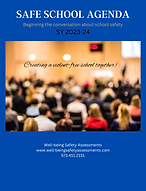Dedicated to Preventing Violence & improving mental health in Schools across the United States
Well-being
Safety Assessments
573.308.2060
School Wellness Assessment
Information

BECOMING A SAFE SCHOOL SY 2023-2024
I. HOW WE PLAN TO IMPROVE SCHOOL SAFETY
a. It is time to start a real conversation about what is needed to promote a safe and secure learning environment for students and faculty. It requires not only the dedication of the school principals, teachers and school resource officers to keep our schools safe but also a collective agreement with all the significant players, including parents, students, emergency responders and the community to come together jointly to help stop school violence. Due to the mental health crisis our world is experiencing, school safety can no longer be the responsibility of just the school administration. We need to work together to prevent tragedies in our educational system.
b. In this meeting, we will discuss what each of these specific "key players" will need to do to support a safe school district. Key players include:
-
School Administration
-
Teachers/Counselors/Faculty
-
Parents
-
Students
-
Emergency Responders
-
Community
SCHOOL ADMINISTRATION
-
Assign a school safety administrator to:
-
-
facilitate quarterly school safety meetings
-
oversee all school safety ledger documentation
-
document and review all intruder drills
-
oversee school safety fundraising
-
schedule, review and follow recommendations of the biannual school wellness assessment
-
schedule, review and follow recommendations of the biannual educator survey (school safety)
-
schedule, review and follow recommendations of the biannual parent survey (school safety)
-
schedule, review and follow recommendations of the annual school safety environmental assessment
-
oversee student safety club
-
promote a safe school through posters, social media and daily school announcements
-
promote positivity and inclusion of all by awarding students and faculty
-
oversee school resource officer(s)
-
oversee school security systems
-
review all school safety reports and determine/follow appropriate action plan
-
-
-
Subscribe and provide monthly mental health reminders to faculty
TEACHERS/COUNSELORS/FACULTY
-
Teachers will complete timely school safety reports to the school safety administrator on students they feel pose a safety concern
-
Teachers will complete timely safety reports on any environmental issue that poses a safety concern (i.e. doors that don't lock appropriately)
-
Teachers will ensure their classroom door is locked once class begins
-
Teachers will arrange classroom to promote a safe and secure environment
-
Teachers will provide box in room for students to report needs and concerns anonymously.
-
Teachers will read monthly Mental Health Reminders.
-
Faculty will wear their school identification badge when on school grounds
-
Faculty will support and follow all school safety protocols
-
Parent Engagement Coordinator will provide parent/student engagement opportunities monthly
-
Counselors will conduct monthly Social Emotional Learning groups with high-risk groups identified with school wellness assessment
-
Counselors will provide educational brochures on current youth issues (i.e. mental health, vaping, eating disorders, depression, etc.)
-
School website will provide resource links for students struggling with mental health concerns (i.e. suicide helpline, drug/alcohol abuse, child abuse, etc.)
PARENTS
-
Parents will report all high-risk behaviors their child is exhibiting to the school in a timely manner (i.e. student states they want to harm themselves or others)
-
Parents will complete biannual parent school safety survey
-
Parents will speak with the school counselor and/or seek outside assistance for children who are struggling with mental health concerns (making friends, low self-esteem, bullying, etc.)
-
Parents will follow all school safety policies (i.e. using main entrance only, signing in and out, etc.)
-
Parents will review and follow results of school wellness assessment for their student (i.e. treatment resource handbook)
STUDENTS
-
Students will complete school wellness assessment biannually
-
Students will participate in social emotional learning groups as recommended
-
Students will utilize classroom boxes/online system to report school safety issues anonymously
-
Students will follow and adhere to all school safety policies
EMERGENCY RESPONDERS
-
Emergency Responders will attend and participate in school safety quarterly meetings
-
Emergency Responders will support school in their effort to provide a safe and secure environment
-
Emergency Responders will provide quarterly safety insight presentations to administration on safety topics (i.e. crisis management, de-escalation, drug/alcohol awareness, etc.)
-
Emergency Responders will participate in quarterly EMS appreciation days at school.
-
School Resource Officers will provide monthly educational groups to youth/faculty
-
School Resource Officers will check-in with weekly with students identified as high-risk on school wellness assessment
-
School Resource Officers will attend current school safety trainings annually
COMMUNITY
-
Community members will actively engage in school safety activities and events (i.e. promoting the positivity of students, supporting educators, school safety fundraising, etc.)
-
Community members will utilize the school helpline if they witness a student(s) being unsafe, overhear suspicious activity or have safety concerns









